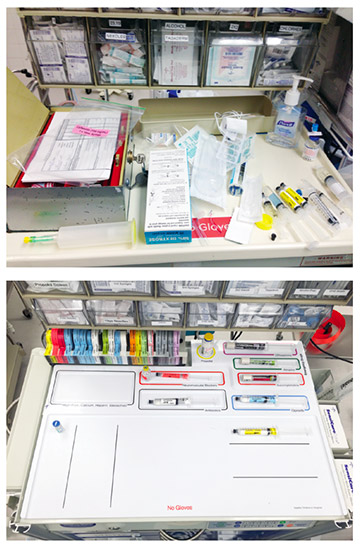Administering medications in the OR is wrought with challenges thanks to the patient's rapidly changing condition and constant distractions occurring in a fast-paced, high-pressure environment. Not to mention that anesthesia providers are solely responsible for verifying, preparing and administering drugs. That unsupervised process is necessarily efficient and nimble, but devoid of the double-checks that can protect patients from medication harm. That's why we created the anesthesia medication template, a simple, low-cost tool that fits on top of the anesthesia cart to create a standardized layout where providers can stage and easily identify drug-filled syringes.
Earlier versions of the template that we created were complicated, making it more restrictive and harder for providers to use effectively. After more than a dozen redesign attempts, we came up with the final product. It features:
- Assigned locations. Syringe wells designated for 3 critical emergency medications (epinephrine, atropine and succinylcholine) are on a raised platform in the upper right corner of the template to sequester and standardize their locations, and to make them easier to identify and grab. Additional surface-level wells are labeled for opioids and neuromuscular blockers (medications that could prove harmful if used inappropriately) and antibiotics (which we had issues with being swapped with opioids and muscle relaxants). All of the designated wells are outlined in color-coded lines according to drug class. We included an additional well in the upper left corner of the template where providers can place syringes filled with medications that they deem to be high risk.
- Free space. Half of the template's surface area is unaffiliated and where providers can place medications of their choosing. We included horizonal lines to act as guides based on our general recommendation to line up filled syringes horizontally in order to make their labels easier to read. We also suggest differentiating flush syringes by lining them up along the vertical lines on the left side of the template.
- Easy maintenance. The template is made of non-porous plastic and features smooth corners, making it easy to clean between cases with germicidal wipes. It's also durable; ours has lasted 6 years and shows no signs of wear and tear.
What made our efforts at improving medication safety unique was the access we had to very smart people at the nearby University of Washington, including interaction design expert Axel Roesler, PhD, MFA. Dr. Roesler's design acumen and non-clinical perspective helped us design a template based on thinking about medication administration in a holistic way.
.svg?sfvrsn=be606e78_3)

.svg?sfvrsn=56b2f850_5)